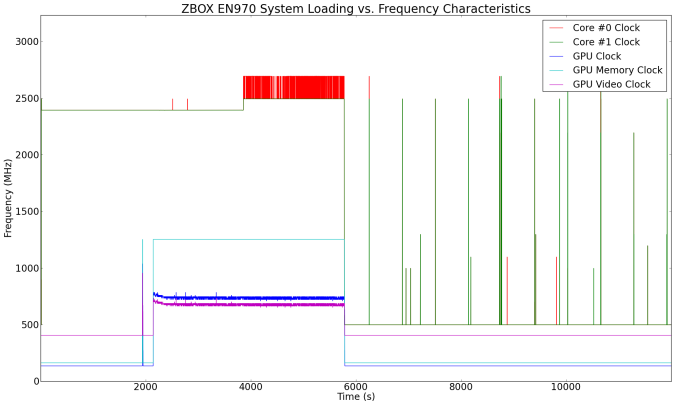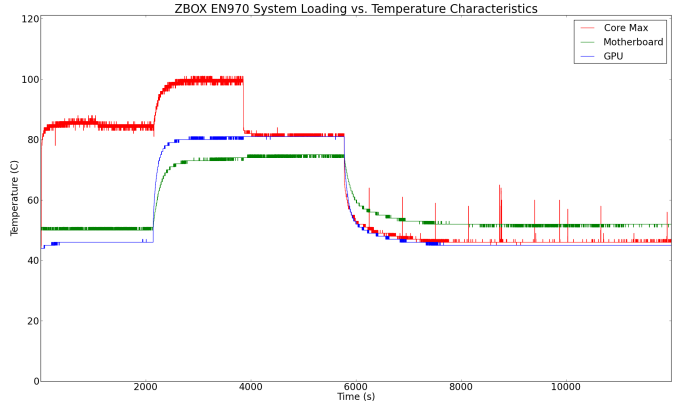Zotac ZBOX MAGNUS EN970 Review - A Gaming mini-PC Done Right
by Ganesh T S on September 28, 2015 8:00 AM ESTPower Consumption and Thermal Performance
The power consumption at the wall was measured with a 1080p display being driven through the HDMI port. In the graphs below, we compare the idle and load power of the Zotac ZBOX MAGNUS EN970 with other low power PCs evaluated before. For load power consumption, we ran Furmark 1.12.0 and Prime95 v27.9 together. Despite consuming close to 19W at idle, the ZBOX MAGNUS EN970 actually happens to be the PC with the lowest idle power amongst all the discrete GPU-equipped machines that we have evaluated so far.


The load power is also amongst the highest in the set of numbers that we have seen till now. However, the big separation between the idle and load powers indicate that the sytem can operate efficiently over a wide range of loading conditions.
Our thermal stress routine starts with the system at idle, followed by 30 minutes of pure CPU loading. This is followed by another 30 minutes of both CPU and GPU being loaded simultaneously. After this, the CPU load gets removed, allowing the GPU to be loaded alone for another 30 minutes. The various clocks in the system as well as the temperatures within the unit are presented below.
According to Intel's official specifications, the junction temperature of the Core i5-5200U is 105C. We find that pure CPU loading keeps the clock frequency half-way between the base frequency (2.2 GHz) and the maximum burst frequency (2.7 GHz). However, the temperature remains well below the junction temperature (around 82C). Getting the GPU into the equation ramps up the motherboard temperature as well as that of the GPU and GPU. However, the CPU remains below the junction temperature despite going up to as high as 102C. The GPU stabilizes around 81C.












88 Comments
View All Comments
BrokenCrayons - Monday, September 28, 2015 - link
Yeah, I'm kind of curious to see how the cooling is configured too and slightly worried about the 102 degree maximum CPU temp. Yes, I get that Intel says everything is awesome up to 105, but there's not much room to wiggle before the poor little processor has to back off which will probably happen as the computer ages and collects some dust in the HSF or if it operates in warmer ambient air. I'd be happy to see it get a good 5-10mm thicker for a cooler running processor with more tolerance for those naughty dust bunnies to build up a little.QinX - Monday, September 28, 2015 - link
Addendum:Also please add the dimension of the device, I can't find them anywhere and although I can go an pixel measure it, having either physical measurements of manufacturer measurements is nice for visualizing size.
donthatethesun - Monday, September 28, 2015 - link
I was curious about the dimensions too. Found them on ZOTAC's website:L 8.27" (210mm) x W 7.99" (203mm) x H 2.07" (52.5mm)
meacupla - Tuesday, September 29, 2015 - link
2.23L, which makes it smaller and better equipped than Asus GR8/GR6 (2.5L).Meaker10 - Tuesday, September 29, 2015 - link
Look at the backplates for the heatsinks, it's soldered on like the CPU.A proper gaming mini PC would use an MXM slot.
milkod2001 - Monday, September 28, 2015 - link
One could buy a laptop with the same specs and have extra portability or full desktop PC coming in small case ( mITX board, Full desktop Intel Quad Core and full 980 GTX all giving 3x better performance ) for $1000 easily. Why would anyone wanted to buy this crappy laptop with no screen or keyboard?I could understand the purpose of these machines as super cheap $200-350 office /streaming devices but at $1000 there is zero value in them.
firewall597 - Monday, September 28, 2015 - link
Seems like an amazing gaming solution for your living room to me...testbug00 - Monday, September 28, 2015 - link
huh? You need a 970m laptop starting at around 1300-1350 currently....Calista - Tuesday, September 29, 2015 - link
Having looked at machines both similar to this Zotac and gaming laptops I tend to agree. Mini PC:s when looking at a pure value perspective seem to have a hard time competing. Which is obviously why they are still a niche segment.The Magnus in my country is $1150, while the MSIGE72 is $1350. The extra $200 for the laptop will give me the same GPU but a much faster quad core i7, 16GB instead of 8GB or RAM and not only a 128GB SSD but also a 1000GB HDD. It will of course also be easily portable and can be used as a laptop. The only problem is the slightly larger size, but since it's flat it can fit in most places.
And if dropping down to a GTX 960M it's actually $100 cheaper to buy a laptop with otherwise similar components as the Zotac, but with a slightly faster CPU.
Calista - Tuesday, September 29, 2015 - link
What we need is a new standard for mini components. At the moment it's a huge delta between a mITX-build and these mini machines. We have in a nutshell a situation in where one size is fit for a system in the 50-100 watt range, another standard (mITX) which could deal with 500 watt of components without overheating or unbearable noise. At the same time a proper gaming system with few compromises seem to demand something in the 200 watt range, i.e. a quad core CPU and a GTX 960 or similar.